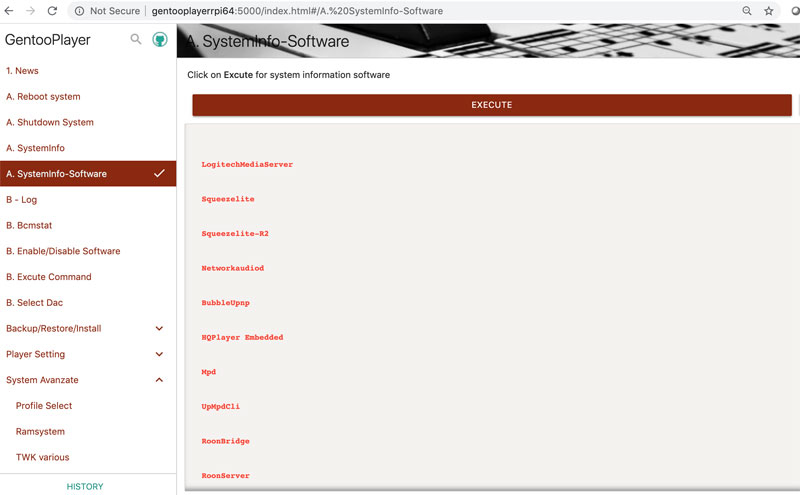-
Please find below a recap of the steps required to install and run Tidal connect on a raspberry. I did this on top of a raspberry pi4 running Moode, but conceptually this should work on any raspberry with Debian. The starting point is coming from this thread on raspberrypi.org: https://www.raspberrypi.org/forums/viewtopic.php?t=297771 Connect to the raspberry using ssh and launch the installation as indicated in https://github.com/shawaj/HiTide url -sSL https://raw.githubusercontent.com/shawaj/HiTide/main/install.sh | sudo bash Modify file "/usr/ifi/ifi-tidal-release/pa_devs/devices" to configure your own audio device The info to be used can be gathered using command "aplay -l" For example, I modified the row of device #1 to enter the info of my USB dac device#1=LA-QXD1: USB Audio (hw:2,0) Modify file "/lib/systemd/system/ifi-streamer-tidal-connect.service" in order to modify as you like the name you want to give to the service using parameters "-f" and "--model name" specify the device audio to b used by the Tidal Connect service by adding the parameter "--playback-device". The value for playback-device needs to be exactly the same inserted at point 2 ....................................... ExecStart=/usr/ifi/ifi-tidal-release/bin/tidal_connect_application \ --tc-certificate-path "/usr/ifi/ifi-tidal-release/id_certificate/IfiAudio_ZenStream.dat" \ -f "Fero Tidal Streamer" \ --codec-mpegh true \ --codec-mqa false \ --model-name "Fero Tidal Streamer" \ --disable-app-security false \ --disable-web-security false \ --enable-mqa-passthrough false \ --log-level 3 \ --enable-websocket-log "0"\ --playback-device "LA-QXD1: USB Audio (hw:2,0)" ...................................... Configure the service for automatic startup at boot: systemctl enable ifi-streamer-tidal-connect.service Usage Notes To start the service, use command: systemctl start ifi-streamer-tidal-connect.service To stop the service, use command: systemctl stop ifi-streamer-tidal-connect.service To verify service status, use command: systemctl status ifi-streamer-tidal-connect.service Please note that when you start the service, "it locks the audio device in exclusive mode", so that if you attempt to access the device in some other way (e.g. with MPD) you will get an error as long as the Tidal connect service will not be stopped. ....I know this is somehow annoying, but the benefits are: 1) as interface, you will use Tidal app, simply selecting where you want the output to go in "Sound Output" 2) for those using Tidal, sound quality is exceptional IMHO!!!!
-
Yes flashed the image on the card using Balena Etcher... Since piCorePlyer is one of the few distros of raspberry that I hadn't tested out yet over the years (RuneAudio, Volumio, Audiophile Linux, Moode, RoopieeeXL, Gentooplayer..) I then tried the official piCorePlayer (ver 7.0.0 23-Dec-2020) and it worked flawlessly at first attempt. It sounds good but probably slightly "thinner" than Squeezelite-R2 on Gentoplayer. In any case, at the end of the day, for the moment I'm staying on Gentooplayer wjhich is giving me many more "tools" to use: in first place I can select on the fly to use either the "LMS+Squeezelite" reproduction ecosystem, or the "MPD+upmpdcli+BubbleUPnPServer" one I have additional "useful" commodities such as Airplay or Spotify Connect I do not use it as NAA for HQplayer or Roon, but I could, should I decide to do it in the future.... I have MinimServer with its intelligent browsing feature which is quite unique.... if well configured it becomes really "unbeatable" for Classical Music properly tagged, IMO superior event to Roon in that espect (the forumer @stefano_mbp is quite knowledgeable about this..)
-
Downloaded the files. put them together with 7zip, flashed the SD card.... it does not boot on my pi4...
-
If yiu qnt to leverage on something already implemented and that needs only some configuration, you might have a look to GentooPlayer. There is also a thread here on audiphilestyle. It provides already services such as squeezelite2 (client for LMS echosystem), or easy configurable "web interface" integration with MPD+upmdcli, either using or not BubbleUPnPServer for streaming.... etc
-
@al2813 you might want to give a try using Gentooplayer on your raspberry pi4. You will still have the opportunity to run Roonbridge on it, but also to experiment with other player options such as LMS+Squeezelite or MPD+upmpdcli....
-
I just asked this specific question on dyiaudio to user cdsganes .....
-
...which I believe was my case!
-
The update to upmpdcli to 1.4.10 worked. So thanks again. About mConnect: the fact is that with mConnect you are actually streaming from your smartphone, so if you exit the app, you stop streaming. With Kazoo (or Lumin App or the newest Linn App etc), the app is indeed only a controller, you are streaming "server side" through upmpdcli and (if you use it) BubbleUPnPServer. Therefore, even if you exit the app, streaming goes on....that's why I usually stream this way.
-
...this was talking about Systeminfo-Software not showing version number of the various components installed and.....yes, gp-update fixed it. Thanks
-

Suggestions for a low-cost DAC?
franz159 replied to Shangri-La's topic in DAC - Digital to Analog Conversion
..answering one year later..... my HiFiMan 400i headphones remained in a drawer at the office in Milan, but the Khadas Tone Board is with me and I'm now "smart working" at home in Rome. Here I use it with 300 Ohms Sennheiser HD600. But in this case i much prefer the sound with a headphone amp in between the Khadas and the headphones, a Linear Tube Audio Micro Zotl 2.. -
I just noticed this news in https://www.lesbonscomptes.com/upmpdcli/ 2020-05-17 upmpdcli 1.4.10 replaces the old Tidal API token, which did not work any more. The raspbian Jessie packages are back, for those people which can't upgrade to a newer Debian. @antonellocaroli which version of upmpdcli did you include in Gentooplayer 2.13? I'm asking because, for some reason, the menu item "Systeminfo-Software" is just listing the installed components, but not their version:
-
Tidal UPnP streaming through BubbleUPnPServer has been working for quite some time. I have been using it in this way since a few year ago, see this post in January 2017. Later, the other distro I was using on my raspberries (Moode) implemented UPnP streaming through upmpdcli in version 4.0.0, released in January 2018. In practice, through upmdpcli it was possible to stream both Qobuz and Tidal without the need of BubbleUPnPServer. IMO BubbleUPnPServer remains anyway preferable since it provides OpenHome compatibility, thus working also with Lumin App for Ipad and not only with Linn Kazoo. Unfortunateky, since October 2019, Qobuz used only with upmpdcli without BubbleUPnPServer stopped working. The reason is explained here: 2019-10-06 Qobuz access was revoked: If you were using Qobuz and it's not working any more, don't pull your hair, the Qobuz plugin stopped working (either through the Media Server or with OHCredentials). Qobuz revoked the app_id, and also deleted the API documentation on Github. If you are a hardware integrator/manufacturer using upmpdcli to support Qobuz access (I know there are some), I made a modification to the Qobuz plugin so that the app_id/secret can be stored externally instead of being embedded in the source. This means that, if you can convince Qobuz to supply you with the appropriate pair, you can easily restore function, without having to support a modified module. Of course, this supposes that the API itself does not change. The question now becomes: is the same happening with Tidal now?
-
Ok I retried, what I missed was to do a reboot after changing the frequencies in "TWK various". Thanks
-
I have version 2.12 I also struggled to change the various frequencies using the menu item "System Avanzate/TWK Various". I tried setting the values to "default", Exceute, the values I wanted, Execute again. But it did not work. At that point I simply updated the file /boot/config.txt with the values I want, the values suggested by Archimago for Raspberry Pi3 here: # Archimago's CRAAP Pi 3 B+ Settings... arm_freq=1000 sdram_freq=500 core_freq=400 gpu_freq=300 ...and the frequencies where set as desired after a reboot.
-
I installed ver 2.1.0 on one of my raspberry (a Pi3B+) with Allo Boss Dac, enabling Squeezelite-R2, MPD bit perfect, upmpdcli and myMPD. I also mounted a samba share (with empty password) from another raspberry in my LAN for my music library and finally activated Ram System Mode 2. It took about 30 minutes to set up, plus 20 minutes or so for myMPD to rescan 1.5Tb of music files. All good at first attempt. Thanks again Antonello!!! This is really an excellent system!


.thumb.jpg.9be1c43978eb8a0fc0e689a1872819ec.jpg)



